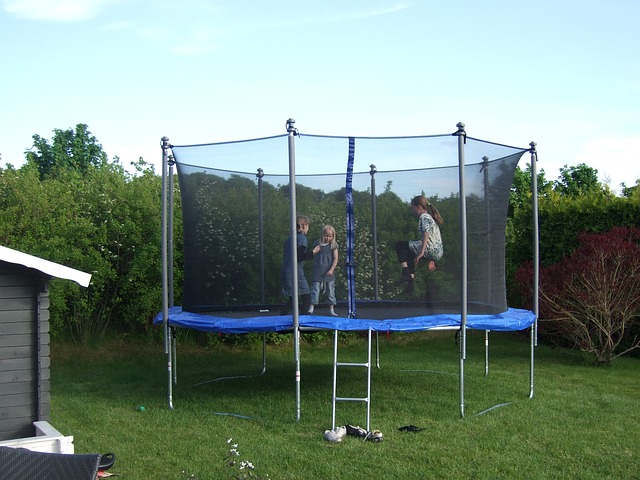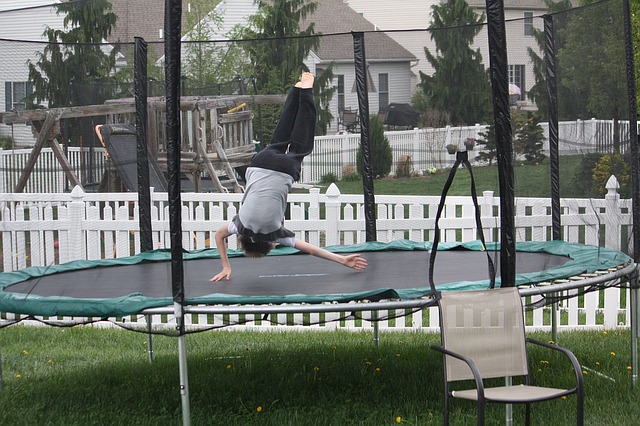People bounce on trampolines for leisure, exercise and competitive purposes, including acrobatics and gymnastic exercises. However, trampolines can also encourage children to venture outside and play rather than remain fixated on a video game, their cell phone, or the television. If you think a trampoline would be a great addition to your space but are unsure of the trampoline sizes available – look no further! We have gathered all the essentials you need to know before purchasing.
What Is a Trampoline?
A trampoline is a device commonly stored in the backyard which people jump up and down on for enjoyment and health. Usually round or rectangular, a trampoline is a metal frame with springs that connects a flat, durable fabric for jumping in the center. This fabric can be a strong synthetic material or mesh, and the springs are often steel, electric straps, or fiberglass.
But how does it work? Trampolines allow people to bounce higher than their initial jump by storing energy from their landing in the springs, and then contracting to propel them back up from the fabric surface. So, whether you want to use a trampoline recreationally or professionally, there are three things to consider prior to purchasing:

Health Benefits
Trampolining is aerobic and works with your cardiovascular system to offer many health benefits, including:
- Redirects energy, which can reduce stress and restlessness
- Promotes blood circulation
- Drains lymph ducts of any toxins so your kidneys can expel them
- Gravitational force of bouncing firms and tightens your cells, slowing the aging process
- Decreases heart rate and blood pressure
- Strengthens muscles
- Reduces cellulite
- Improves your balance
The fabric surface that lines a trampoline absorbs the full force of your landing when you jump to prevent jarring of your knees, ankles and hips, making it an easy, low-impact exercise for people of all ages. A recent NASA study found that jumping on a trampoline for 10 minutes offers the same benefits as running for 30 minutes!
The Safety
Jumping on a trampoline can be incredibly fun, but it can also cause sprains and fractures in arms or legs, and serious cases — head and neck injuries. The risk is higher for children, so most trampolines now come with a safety net to enclose the jumping space and reduce the chance of accidents. Nothing replaces your supervision, but if the model you decide on doesn’t come with a net, we recommend purchasing one to avoid unnecessary worry.
Location
Position your trampoline on soft ground, like bark or grass, so it can absorb the impact energy from the jumps, allow for proper drainage, and suppress weeds. You should avoid concrete or tarmac as they are too hard and risk injury.

Is There a Need for Different Trampoline Sizes?
Not one buyer will be the same as another, so trampoline sizes need variation to cater for the differing demands of customers. Second to budget, trampoline size is the most important factor you should consider prior to purchasing, as various other factors influence it, including:
- The size of your yard or space
- The number of people who will use the trampoline
- The ages of the people who will use the trampoline
- The weight of the people who will use the trampoline (some have limitations)
- The frequency of use
- Ground surface (needs a soft surface like bark, not concrete)
- Obstructions like low-hanging trees and overgrown plants
If you have a small yard, a standard size trampoline (12ft) may be too large, while a 32″ rebounder trampoline may be too compact and limit the intensity of your exercise. So it is important that you know the purpose of the trampoline and who will use it to decide its location and the size.
However, size refers not only to the diameter of a trampoline but also its height from the ground.
Trampoline Heights
For smaller 6ft to 8ft trampolines, the height from ground will be approximately 2ft and the total height will be 6ft with the safety enclosure net. Similarly, for larger trampolines over 10ft, the height from the ground will be approximately 3ft and the total height will be 8ft with the safety enclosure net. These dimensions can also influence weight limitations.
Size vs Weight
Variations in size will also influence weight restrictions, as even the largest trampolines have limits. Prior to purchasing, look up the maximum weight the trampoline can manage on the box or within the instruction booklet and cross check it against the people who will use it.
It is important to note that rectangular trampolines have different weight considerations than round trampolines, as they are larger with a firmer bounce. These larger trampolines are less popular for small children, as the fabric surface is wider and the springs are tighter than on a round trampoline, making it harder for them to build momentum to bounce properly.

Jumping Surface Areas
The size of a trampoline will influence the size of the jumping surface area which will support or limit certain bounces, tricks and exercises. We have looked at the two most popular trampoline sizes to give a general idea. A 10ft trampoline has a total jumping surface area of 63 sq. The standard 12ft trampoline has a total jumping surface area of 93 sq. ft.
Measuring Trampoline Sizes
Knowing the size of your yard is one thing, but judging the size of a trampoline is another. We recommend visiting your local hardware or department store (whichever stocks the trampolines you’re interested in) with a measuring tape to check the dimensions of the floor stock models, before buying the box and taking it home!
Measuring Round Trampolines
To measure a round trampoline, place your measuring tape at a point on the outer metal edge of the frame and take the tape straight across the fabric in the center to the exact point on the opposite side of the frame. Note down this figure as ‘Measurement 1’ and then move your measuring tape perpendicular to ‘Measurement 1’, to find ‘Measurement 2’. Add Measurement 1 and Measurement 2, then divide by 2 to get the size.
Measuring Rectangular (or Square) Trampolines
To measure a rectangular or square trampoline, place your measuring tape at a point on the outer metal edge of the frame of a shorter side and take the tape across the fabric in the center to the opposite short side. Then measure the frame diameter, by measuring the length of one of the longer sides from frame edge to frame edge. These two measurements will make up the dimensions of your square or rectangular trampoline.
Manufacturers tailor the shape and diameter of trampolines to meet the demands of the users, so once you have worked out how large your yard is, how many people will use the trampoline, and their ages and weights, you will be ready to work out the best option for you that doesn’t break the budget!
What Trampoline Sizes Are Available?

A standard trampoline can range in size from 10ft to 15ft, but there are various trampoline sizes available outside of these parameters for children and indoor exercise. The smallest starts at 32 inches for a round, rebounder trampoline and increases to 17ft for a rectangular Olympic/Gymnastics trampoline. We have broken down the various sizes for your reference:
For Kids
If only children will use your trampoline, you won’t need a standard size, so we recommend considering one of the following smaller trampoline sizes:
- 36″ for children aged 3 years old
- 38″ for children aged 3 years old
- 40″ for children aged 3 years old
- 48″ for children aged 3 to 5 years old
- 55″ for children 3 to 5 years old
- 3ft for children 3 to 5 years old
- 7ft for children 3 to 5 years old
- 10ft for children 6 to 11 years old (outside trampoline)
- Standard 12ft for children 12 years and over (outside trampoline)
Trampoline Rebounders
These mini trampolines are normally round and used indoors for fun or adult exercise. They are low to the ground and come in the following sizes:
- 32″
- 36″
- 38″
- 40″
- 49″
Outdoor Trampolines
These large scale trampolines are normally round or rectangular and require a designated place in your backyard that has soft ground and no overhanging trees. Outdoor trampolines come in the following sizes:
- 6ft-10ft for smaller backyards
- 12ft-15 ft for standard backyards
- 16ft-17ft for large spaces
It is important to note that if you have a large family or predict that most of the neighborhood kids will want to share in your new trampoline, you should consider purchasing a larger size. We recommend anything over 14ft for more flexibility, durability and the freedom to have 2 people jumping at the same time. Larger trampoline sizes also allow for easier use and enjoyment by the older members of the family.

Conclusion
Trampolines are hours of fun for the whole family and can keep you active, healthy and happy, but deciding on a size that will suit your space, family needs and budget, before you browse is crucial. We hope this article has given you the confidence to know the various trampoline sizes available and decide what is right for you.
Leave a Reply